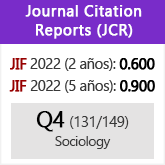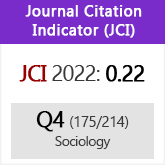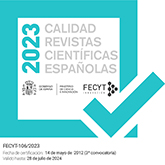La integración de los inmigrantes de “segunda generación” en Almería. Un caso de pluralismo fragmentado
DOI:
https://doi.org/10.3989/ris.2008.04.17Palabras clave:
Aculturación, Asimilación segmentada, Jóvenes, Multiculturalidad, TransnacionalismoResumen
El objetivo de este artículo es conocer el proceso de integración de los inmigrantes de “segunda generación” en la provincia de Almería (España). Para ello vamos a analizar la adaptación que están experimentando los jóvenes en las siguientes dimensiones: socioeconómica, relaciones mixtas, referentes culturales, normas y transnacionalidad. Los datos se obtienen a partir de la administración de un cuestionario en diferentes centros educativos y en el ámbito residencial; la muestra final está formada por un total de 390 encuestas. Los resultados muestran que no todos los inmigrantes de segunda generación tienen la misma adaptación; se plantean, por el contrario, situaciones dispares, lo que dibuja un escenario de pluralismo fragmentado. El origen, los años de estancia, el nivel de estudios, la profesión y el hábitat son las variables que predicen fundamentalmente este proceso.
Descargas
Citas
Alba, R.D. 2005. “Bright vs blurred boundaries: second-generation assimilation and exclusion in France, Germany and the United States”. Ethnic and Racial Studies 28: 20-49. doi:10.1080/0141987042000280003
Alba, R.D. y V. Nee. 1997. “Rethinking assimilation Theory for a new era of immigration”. International Migration Review 31: 826-874. doi:10.2307/2547416 PMid:12293207
Alba, R. D. y V. Nee. 2003. Remaking the American Mainstream: Assimilation and Contemporary Immigration. Harvard: Harvard University Press.
Álvarez de Sotomayor, A. 2007. “¿La etnia como fuente de capital social? Una lectura crítica del análisis de redes co-étnicas como factor de logro educativo de los alumnos inmigrantes. Documento de trabajo 0407: IESA-CSIC.
Aparicio, R. 2007. “The Integration of the Second and 1.5 Generations of Moroccan, Dominican and Peruvian Origin in Madrid and Barcelona”. Journal of Ethnic and Migration Studies 33: 1169-1193. doi:10.1080/13691830701541713
Aparicio, R. y A. Tornos. 2006. Hijos de inmigrantes que se hacen adultos: marroquíes, dominicanos y peruanos. Madrid: Ministerio de Trabajo.
Arjona, A. 2006. Los colores del escaparate. Emprendedores inmigrantes en Almería. Barcelona: Icaria.
Arjona, A., J. C. Checa, F. Checa y Olmos y M. García. 2008. Jóvenes inmigrantes y educación en España. Variables que afectan en su incorporación a la universidad de Almería: propuestas de actuación. Granada: Comares.
Banton, M. 2001. “National integration in France and Britain”. Journal of Ethnic and Migration Studies 27: 151-168. doi:10.1080/13691830124752
Baldwin-Edwards, M. 1999. “Where Free Markets Reign: Aliens in the Twilight Zone”, en Baldwin-Edwards, M. y J. Arango (eds). Immigrants and the Informal Economy in Southern Europe, pp. 1-15. Portland: Frank Cass Publishers.
Brubaker, W. R. 1992. Citizenship and nationhood in France and Germany. Cambridge: Harvard University Press.
Brubaker, W. R. 2001. “The return of assimilation? Changing perspectives on immigration and its sequels in France, Germany and the United States”. Ethnic and Racial Studies 24: 531-548. doi:10.1080/01419870120049770
Carbonell, F. 1995. Inmigración: diversidad cultural, desigualdad social y educación. Madrid: MEC.
Carrera, S. 2006. “Programas de integración para inmigrantes: una perspectiva comparada en la Unión Europea”. Migraciones 20:37-73.
Carvalho, F. 2005. Descendentes de caboverdianos em Portugal. A questao identitária. Lisbon: SociNova.
Checa, F. (dir.) 2007a. Mapa de la inmigración en Almería. Necesidades y recursos. Almería: Diputación de Almería.
Checa, J. C. 2007b. Viviendo juntos-aparte. La segregación espacial de los africanos en Almería. Barcelona: Icaria.
Child, I. L. 1943. Italian or American? The second generation in conflict. New Haven: CTYale University Press. Christou, A. 2006. “American dreams and European nightmares: experiences and polemics of secondgeneration greek-american returning migrants”, Journal of Ethnic and Migration Studies 32: 831-845.
Christou, A. y R. King. 2006. “Migrants encounter migrants in the city: the changing context of home for second-generation greek-american return migrants”. International Journal of Urban Regional Research 30: 816-835. doi:10.1111/j.1468-2427.2006.00697.x
Conzen, K. N. 1991. “Mainstreams and side channels: The localization of immigrant cultures”. Journal of American Ethnic History 10:5-20.
Crul, M. y H. Vermeulen. 2003. “The second generation in Europe”. International Migration Review. 37: 965-986.
Crul, M. y H. Vermeulen. 2006. “Immigration education and the turkish second generation in five European nations: a comparative study”. En C. Parson y Smeeding, T. (eds.). Immigration and the transformation of Europe. Cambridge: University Press.
De Miguel, V. y C. Carvajal. 2007. “Percepción de la inmigración y relaciones de amistad con los alumnos extranjeros en los institutos”. Migraciones 22: 147-190.
Fase, W. 1994. Ethnic divisions in western European education. Münster: Waxmann.
Franzé, A. 1997. Lo que sabía no valía. Escuela, diversidad e inmigración. Madrid: Universidad Autónoma de Madrid.
Gans, H. 1992. “Second generation decline: scenarios for the economic and ethnic futures of the post 1965 immigrants”. Ethnic and Racial Studies 15: 173-192.
Garreta, J. 2006. “Ethnic minorities and the Spanish and Catalan educational systems: from exclusion to intercultural education”. International Journal of Intercultural Relations 30: 261-279. doi:10.1016/j.ijintrel.2005.11.006
Glazer, N. y D. P. Moynihan. 1970. Beyond the Melting Pot: The Negroes, Puerto Ricans, Jews, Italians, and Irish of New York City. Cambridge: MIT Press.
Glick Schiller, N. 1999. “Transmigrants and Nation-States: Something Old and Something New in the U.S. Immigration Experience”, en Hirschman, C., P. Kasinitz y J. De Wind (eds.). The Handbook of International Migration, pp. 94-119. New York: Russell Sage.
Glick Schiller, N., L. Basch, y C. Szanton. 1992. “Towards a transnational perspective on migration: race, class, ethnicity and nationalism reconsidered”. Annals of the New York Academy of Sciences 645: 125-143.
Gordon, M. 1964. Assimilation in American Life: The Role of Race, Religion and National Origins. New York: Oxford University Press.
Gualda, E. 2007. “Researching second generation in a transitional, european and agricultural context of reception of immigrants”. Working paper series. The Center for Migration and Development: Princeton University.
Gualda, E. y E. Sánchez. 2007. “Integración laboral: una perspectiva desde los contratos”. En E. Gualda (dir.) Hacia un trabajo decente. Inserción sociolaboral de la población extranjera en Andalucía, pp. 137-266. Sevilla: Junta de Andalucía.
Guarnizo, L.E. 2003. “The economics of transnational living”. International Migration Review 37: 666-99.
Hartmann, D. y J. Gerteis. 2005. “Dealing with diversity: mapping multiculturalism in sociological terms”. Sociological Theory 32: 218-240. doi:10.1111/j.0735-2751.2005.00251.x
Herranz, G. 2008. “Xenofobia: un estudio comparativo en barrios y municipios almerienses”. Revista Española de Investigaciones Sociológicas 121: 107-132.
Juliano, D. 1993. Educación intercultural. Escuelas y minorías étnicas. Madrid: Eudema.
Kao, G. y M. Tienda. 1995. “Optimism and achievement: The educational performance of immigrant youth”. Social Science Quarterly 76: 1-19.
King, R., A. Fielding y R. Black. 1997. “The International Migration Turnaround in Southern Europe”, en R. King y R. Black (eds). Southern Europe and the New Immigrants, pp. 1-25. Portland: Sussex Academic Press.
Mingione, E. 1995. Las sociedades fragmentadas. Una sociología de la vida económica más allá del paradigma del trabajo. Madrid: Ministerio de Trabajo y Asuntos Sociales.
Muus, P. 2002. Migration and immigrant policy, immigrants from Turkey and their participation in the labour market: an international comparison. Utrech: ERCOMER.
Navas, M. S. et al. 2004. Estrategias y actitudes de aculturación: la perspectiva de los inmigrantes y de los autóctonos en Almería. Sevilla: Junta de Andalucía.
Niessen, J., Th. Huddleston y L. Citron. 2007. Índice de políticas de integración de inmigrantes. Londres: Brithish Council.
Noiriel, G. 1992. Population, immigration et identité nationale en France XIX-XX siècle. París: Hachette.
Pérez Yruela, M. y S. Rinken. 2005. La integración de los inmigrantes en la sociedad andaluza. Córdoba: CSIC.
Perlmann, J. 1988. Ethnic Differences: Schooling and Social Structure among the Irish, Jews, and Blacks in an American City, 1988-1935. New York: Cambridge University Press.
Perlman, J. y R. Waldinger. 1997. “Second generation decline? Children of immigrants, past and present. A reconsideration”. International Migration Review 31: 1415-1430. doi:10.2307/2547418 PMid:12293209
Portes, A. y J. Böröcz. 1989. “Contemporary Immigration: Theoretical Perspectives on Its Determinants and Modes of Incorporation”. International Migration Review 23: 606-630. doi:10.2307/2546431 PMid:12282796
Portes, A. y J. Dewind. 2004. “A cross-Atlantic dialogue: the progress or research and theory in the study of International Migration”. International Migration Review 38: 828-851.
Portes, A., L. Guarnizo y P. Landolt. 1999. “The study of transnationalism: pitfalls and promise of an emergent research field”. Ethnic and Racial Studies 22: 217-137. doi:10.1080/014198799329468
Portes, A. y R. Rumbaut. 2006. Immigrant in America. A portrait. California: University of California.
Portes, A. y M. Zhou. 1993. “The New Second Generation: Segmented Assimilation and Its Variants”. Annals of the American Academy of Political and Social Science 530: 74-96. doi:10.1177/0002716293530001006
Roquero, E. 1996. “Asalariados africanos trabajando bajo plástico. Un caso de segregación en el poniente almeriense”. Sociología del Trabajo 28: 3-23.
Rinken, S. 2006. “¿Vivir transnacional? Envío de remesas versus arraigo en la sociedad de acogida: el caso de Andalucía”. Migraciones 20: 173-199.
Safi, M. 2006. “Le processus d’intégration des immigrés en France: inégalités et segmentation”. Revue Française de Sociologie 47: 49-79.
Schnapper, D. 1999. “Traditions nationales et connaissance rationnelle”. Sociologíe et Société 31:15-26.
Thomson, M. y M. Crul. 2007. “The second generation in Europe and the United Status: how is the transatlantic debate relevant for further research on the European second generation?”. Journal of Ethnic and Migration Studies 33: 1025-1041. doi:10.1080/13691830701541556
Tribalat, M. 1996. De l’immigration à l’assimilation. París: INED.
Warner, W. L. y L. Srole. 1945. The Social Systems of American Ethnic Groups. New Haven: Yale.
Xie, Y. y E. Greenman. 2005. “Segmented Assimilation Theory: a Reformulation and Empirical Test”. Documento de trabajo del Institute for Social Research: Universidad de Michigan.
Zhou, M. 1997. “Segmented Assimilation: Issues, Controversies and Recent Research on the New Second Generation”. International Migration Review 31: 975-1008. doi:10.2307/2547421 PMid:12293212
Zanfrini, L. 2004. Sociologia delle migrazioni. Roma: Laterza.
Descargas
Publicado
Cómo citar
Número
Sección
Licencia
Derechos de autor 2009 Consejo Superior de Investigaciones Científicas (CSIC)

Esta obra está bajo una licencia internacional Creative Commons Atribución 4.0.
© CSIC. Los originales publicados en las ediciones impresa y electrónica de esta Revista son propiedad del Consejo Superior de Investigaciones Científicas, siendo necesario citar la procedencia en cualquier reproducción parcial o total.Salvo indicación contraria, todos los contenidos de la edición electrónica se distribuyen bajo una licencia de uso y distribución “Creative Commons Reconocimiento 4.0 Internacional ” (CC BY 4.0). Puede consultar desde aquí la versión informativa y el texto legal de la licencia. Esta circunstancia ha de hacerse constar expresamente de esta forma cuando sea necesario.
No se autoriza el depósito en repositorios, páginas web personales o similares de cualquier otra versión distinta a la publicada por el editor.

















